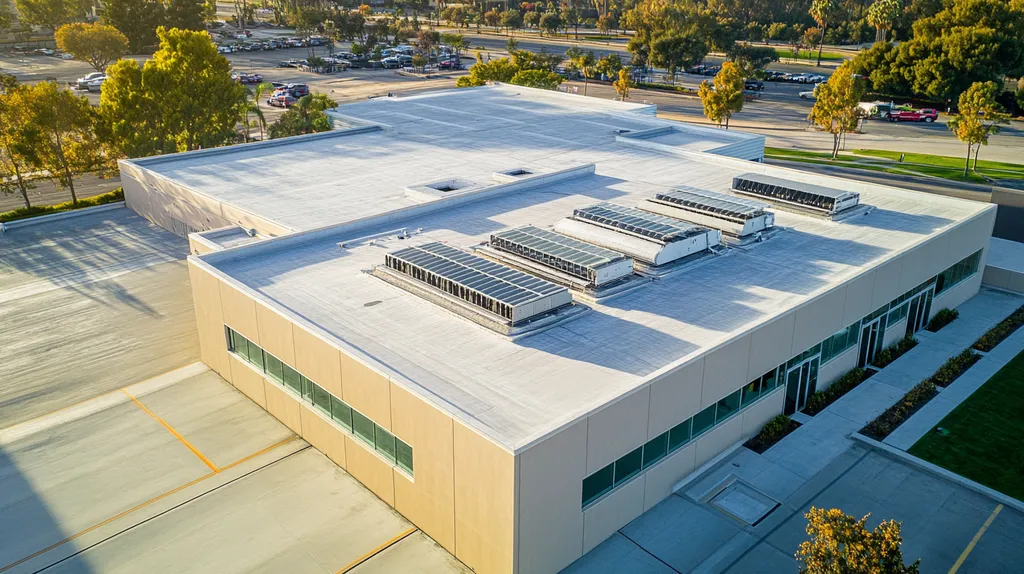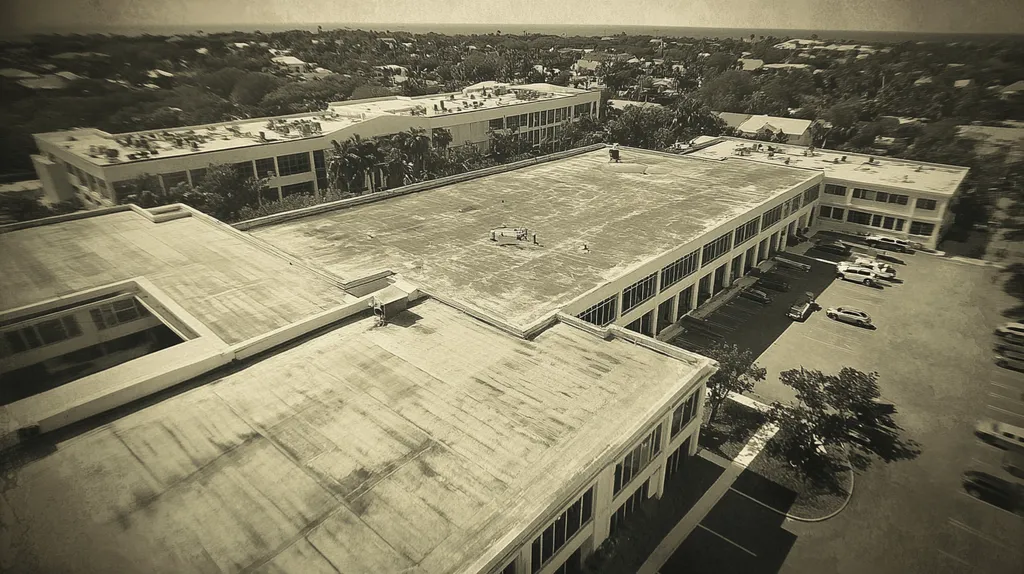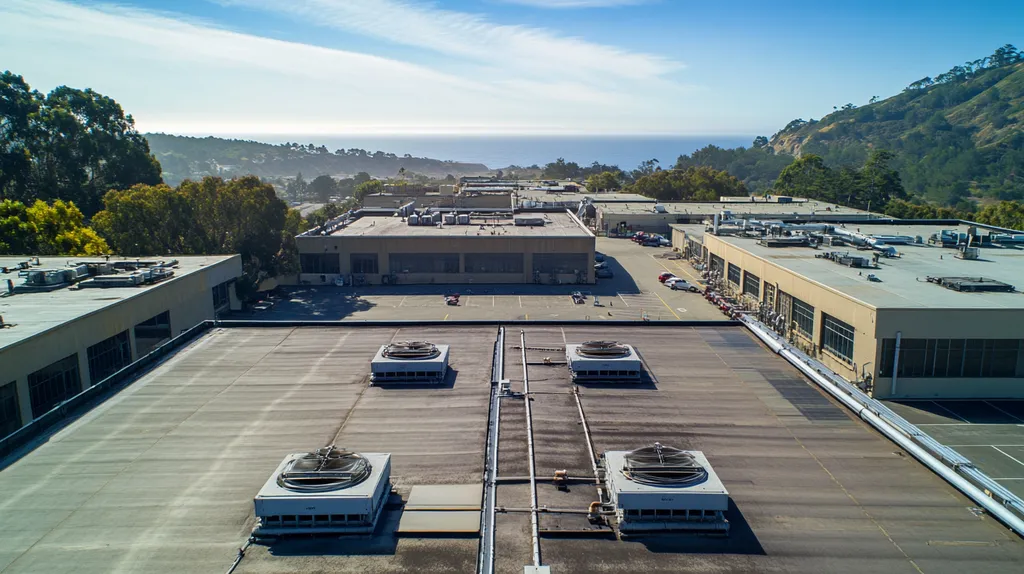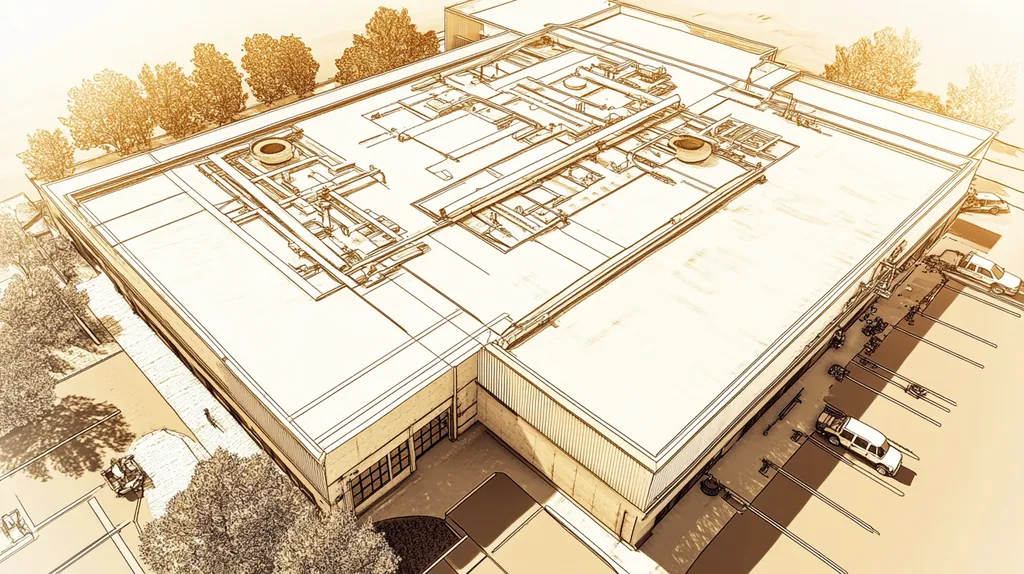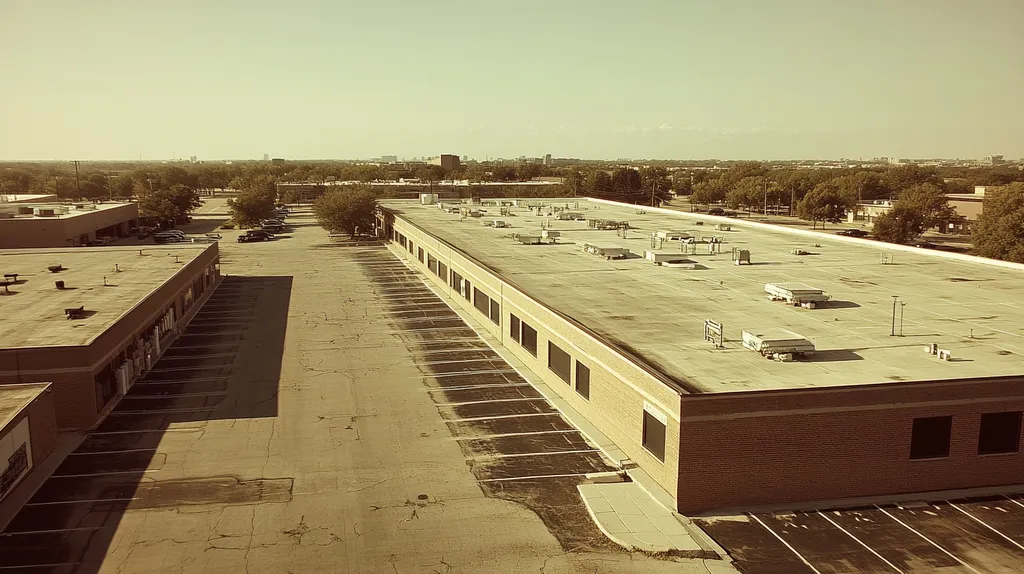When winter unleashes its fury on commercial roofs, the consequences can be devastating. Industry data shows that cold-climate roofing failures cost businesses over $3 billion annually in repairs, damage, and lost productivity.
From sneaky ice dams that quietly undermine structural integrity to freeze-thaw cycles that wage a constant battle against roofing materials, the challenges are as numerous as snowflakes in a blizzard.
This comprehensive guide explores the critical aspects of cold-climate commercial roofing, from fundamental concepts to optimization strategies, helping property owners protect their investments when temperatures plummet.
SECTION 1: FUNDAMENTAL CONCEPTS
For property owners, grasping the challenges faced by commercial roofs in cold climates is not just important—it’s essential. In regions where the thermometer frequently dips below freezing, roofs encounter unique stressors that can lead to serious problems like leaks, structural damage, and expensive repairs. By identifying these challenges early, property owners can implement proactive strategies to protect their investments and ensure that their roofs stand the test of time.
Climate-Specific Roofing Challenges
Cold climates bring with them a host of roofing challenges that demand serious attention. For starters, heavy snow accumulation can weigh down roofs disproportionately, putting structural integrity at risk. Materials suitable for balmy climates may falter against the rigors of winter, resulting in diminished lifespan and performance.
Moreover, moisture build-up combined with inadequate drainage can create ice dams, causing water to back up beneath shingles and membranes. This scenario hardly ends well, with leaks and internal damage lurking around the corner.
Design considerations also take center stage. Areas that receive heavy snowfall may require pitched roofs to facilitate efficient snow shedding, thus minimizing risk.
Selecting the right materials and design strategies is vital for long-lasting performance in harsh winters. Neglecting these challenges can lead to costly repairs, not to mention putting the safety of building occupants in jeopardy.
Impact of Freeze-Thaw Cycles
Freeze-thaw cycles pose a notable threat to commercial roofing systems in cold climates. These cycles occur when moisture freezes, expands, thaws, and contracts, generating stress on the roofing materials. Over time, this relentless cycle can result in cracking, warping, and even separated seams.
Common materials—such as asphalt and certain membranes—can lose their elasticity with repeated freeze-thaw exposure, opening the door to greater vulnerability. This ongoing deterioration compromises the roof’s waterproofing capabilities and can escalade energy costs as thermal insulation grows less effective.
Surface erosion caused by freeze-thaw cycles can strip away loose granules and materials, leading to additional challenges. Regular inspections and consistent maintenance become crucial in catching these issues before they spiral out of control.
By understanding freeze-thaw effects, property owners can proactively implement preventative measures, ensuring roofs will last longer and perform reliably.
Thermal Shock and Roof Integrity
Thermal shock occurs when sudden temperature changes stress roofing materials, and this can be particularly disruptive in cold climates. For instance, a wintry day may see the sun rapidly warm an icy surface, causing swift, uneven expansion. Meanwhile, the drop in evening temperatures can lead to equally rapid contraction.
This constant thermal shifting puts wear on roofing systems and can lead to cracks and separations at seams and joints. If ignored, such damage can result in leaks and a compromised building envelope.
The choice of materials becomes critical in combatting thermal shock. Some materials stand up better than others, allowing property owners to reduce risks associated with temperature fluctuations.
Insulation quality also plays a significant role; high-quality insulation can buffer temperature fluctuations, thereby lessening the impact of thermal shock. Routine assessments can highlight vulnerabilities susceptible to these stresses, allowing timely repairs before minor issues escalate.
Proactively managing thermal shock effects is essential. With proper planning and informed material choices, roofs can power through temperature challenges while maintaining their structural integrity.
SECTION 2: SYSTEM COMPONENTS
In cold climates, the stakes for maintaining the structural integrity of commercial roofs couldn’t be higher. Ineffective system components can lead not only to costly repairs but also to unexpected energy bills that can drain profits. According to the National Roofing Contractors Association, inadequate insulation and ventilation can result in significant heat loss, costing property owners thousands over time. This section dives into the essential elements of insulation, drainage, and material selection, all critical to ensuring a resilient roofing system even in the harshest conditions.
Insulation and Ventilation Systems
Think of insulation as the backbone of your roofing system in frigid climates. With a high R-value, insulation keeps heat indoors where it’s needed, significantly lowering heating costs. Effective ventilation complements this by keeping moisture at bay, warding off mold growth and potential structural damage.
Many commercial roofs incorporate rigid board insulation or spray foam, both known for their stellar thermal resistance. However, even the best materials won’t perform well if they aren’t installed correctly, potentially leaving air leaks that waste energy. A common misstep is neglecting ventilation, which can trap warm, moist air beneath the roof membrane.
When warm air escapes from the building, it can lead to the development of ice dams at the roof edges. These pesky formations can back up water, leading to leaks and expensive repairs. Regular inspections and a well-designed ventilation system are key to avoiding these pitfalls.
In short, property owners must prioritize insulation and ventilation to protect their investments. High-quality materials and meticulous installation can extend the life of the roof and enhance energy efficiency, ultimately paying dividends down the line.
Drainage and Water Management
Water management is critical for commercial roofs, especially in snowy regions. Ineffective drainage can lead to dangerous water pooling, which adds serious weight and may compromise structural integrity. This issue worsens when melting snow refreezes, turning into ice blocks that can choke drainage systems.
Properly designed drainage systems, including gutters and downspouts, are non-negotiable. They must be adequately sized to accommodate the expected volume of snowmelt and rainfall. Roof designs should facilitate positive drainage, efficiently directing water away from vulnerable areas and towards suitable outlets.
Utilizing tapered insulation can also help create slopes for improved drainage. This one simple solution can prevent water pooling and safeguard the roof’s structural integrity. Regular maintenance to keep drainage pathways clear should be standard procedure.
If water isn’t managed effectively, long-term damage can become a costly reality. Thus, regular assessments of drainage systems are vital, enabling timely adjustments that protect roofing assets.
Roofing Materials for Cold Climates
Selecting the right roofing materials is crucial for enduring performance in cold climates. Materials like thermoplastic polyolefin (TPO) and ethylene propylene diene monomer (EPDM) are popular choices thanks to their durability and reflective properties. These systems are designed to withstand extreme temperatures and resist cracking.
Additionally, roofing membranes need to manage freeze-thaw cycles without breaking down. A material that resists moisture absorption is essential to prevent the formation of ice. The ideal roofing solution not only protects the underlying structure but also boosts energy efficiency.
Considering coatings is another proactive strategy. Quality coatings can enhance thermal resistance and extend the life of your roofing system by reflecting harmful solar radiation, reducing cooling costs in warmer months.
Ultimately, consulting with roofing professionals can guide property owners toward materials that meet the specific challenges of cold climates. Making informed choices helps ensure your roof can withstand harsh weather while maximizing its lifespan and performance.
SECTION 3: IMPLEMENTATION METHODS
Getting roofs ready for the heavy snowfalls that can blanket commercial buildings in cold climates is a must-do for property owners. If roofs aren’t designed, installed, and fortified correctly, they can buckle under the weight, leading to costly structural failures that send repair bills through the roof—literally! This section dives into essential strategies that can bolster roof performance, such as designing for snow load capacity, installing robust roofing systems, and integrating weather-resistant features.
Designing for Snow Load Capacity
Knowing how to calculate snow load capacity is a game changer for commercial roofs in chilly climates. Too much weight from accumulated snow can push roofs to their breaking point. To avoid disasters, it’s crucial to base load-bearing calculations on local snowfall averages combined with historical weather patterns.
Building codes often provide a baseline for snow load requirements, but that’s just the tip of the iceberg. Properties in snow-heavy regions might need roofs engineered to handle extra stress from extreme weather events.
Teaming up with roofing professionals can take designs to new heights. They can analyze factors like roof slope and building height to create structures that can stand tall against winter’s wrath.
Regular evaluations during snow events can also be proactive. Making the investment in structural reinforcements now can save property owners from costly liabilities later. Never underestimate the power of good design when it comes to snow loads!
Installing Robust Roofing Systems
The materials matter—big time! When it comes to roofing systems suited for frosty climates, conventional materials might not cut it. Options like modified bitumen, thermoplastic polyolefin (TPO), and standing seam metal roofs have proven their worth, handling cold weather much better than traditional choices.
But it’s not just about what materials are picked; how they are installed is crucial as well. A skilled contractor can make all the difference, ensuring that each component fits perfectly and attains maximum performance. A poorly installed system, even if made from top-notch materials, can lead to vulnerabilities down the line.
Regular monitoring and a proactive maintenance plan will pay off in spades. Features like scheduled inspections can uncover issues before they snowball into more significant headaches.
Investing in high-quality materials and proper installation may feel like a bigger hit to the budget up front, but it’s a long-term win that reduces repair needs and enhances durability.
Integrating Weather-Resistant Features
To truly weatherproof roofs, it’s essential to incorporate features that protect against the elements. Effective insulation isn’t just a luxury; it’s a necessity! Quality insulation helps keep indoor temperatures stable, reduces heating costs, and prevents the dreaded ice dam formation.
Another vital aspect is a well-designed drainage system. Clogged drains can turn your roof into a swimming pool during melting times, leading to increased snow load that can collapse your roof. A thought-out drainage system will channel melting snow away efficiently, reducing ice formation risks.
Don’t overlook ventilation, either! By ensuring good airflow through the roof structure, moisture buildup becomes a nonissue, helping roofing materials last longer. Incorporating ridge and soffit vents can provide that essential airflow boost.
By addressing these crucial weather-resistant features, property owners set up their roofs for a long-lasting performance that stands the test of time and nature alike.
SECTION 4: MAINTENANCE REQUIREMENTS
Maintaining commercial roofs in cold climates is not just important; it’s a necessity for safeguarding your investment. When snow accumulates unchecked, roofs can face catastrophic structural issues that could lead to expensive repairs or worse. Studies reveal that regular maintenance can extend a roof’s lifespan by nearly 50%. This section highlights proactive snow removal methods, the importance of scheduled preventative maintenance, and effective strategies for addressing ice dams and ponding.
Regular Snow Removal Techniques
Excess snow can weigh down roofs to dangerous levels, threatening their structural integrity. Property managers need a reliable snow removal plan to mitigate this risk. Techniques, such as utilizing snow rakes for low-pitched roofs or hiring specialized contractors for steep or high areas, are crucial elements of a solid strategy.
For roofs in high-snow regions, understanding snow load limits is essential. Each commercial roof should be evaluated for its capacity to handle localized snow loads and cleared promptly to prevent melted snow from refreezing into damaging ice layers.
It’s also vital that snow management teams are trained to avoid damaging roofing membranes during the removal process. A careful, methodical approach minimizes the chance of unintended punctures or other harm that could require repairs.
In summary, regular snow removal isn’t just good practice; it’s a crucial maintenance task that safeguards against costly repairs and extends the roof’s overall lifespan.
Preventative Maintenance Schedules
A solid preventative maintenance schedule is paramount for commercial roofs in frigid climates. Regular inspections help catch issues before they develop into bigger problems. Scheduling inspections at least twice a year—ideally in spring and fall—provides a strategic opportunity to assess the roof’s condition thoroughly.
During these inspections, facility managers must look for weak points, such as worn membranes or deteriorating flashing. Keeping detailed records of changes and repairs made during inspections allows for better tracking of the roof’s health over time. Promptly fixing minor issues like leaks or tears can prevent costly repairs down the line.
To enhance overall roof longevity, a seasonal checklist—like ensuring drains are clear post-winter—can be beneficial. Preventative maintenance goes beyond being an operational task; it’s a critical investment in protecting valuable assets.
In short, a consistent and thorough preventative maintenance schedule is essential. It protects against long-term issues that can arise in harsh climates, offering peace of mind and financial savings.
Addressing Ice Dams and Ponding
Ice dams and ponding are two prevalent challenges for roofs in cold climates. Ice dams form when melting snow refreezes at the roof edges, creating barriers that can trap water and lead to leaks inside the building if not managed properly.
To combat ice dams, property managers should ensure adequate insulation and ventilation to help maintain a stable roof surface temperature. Installing heated cables along roof edges can provide an extra layer of preventative action by promoting controlled melting and effective drainage.
Ponding, on the other hand, occurs when standing water collects on the roof surface due to drainage issues. It’s crucial to ensure that all drainage systems are clear and functioning correctly. Regular inspections help identify instances of ponding, enabling swift action to remedy the situation.
Both ice dams and ponding necessitate proactive strategies from property owners to maintain roof integrity. Timely attention to these challenges can save significant costs and prevent extensive water damage repairs.
SECTION 5: PERFORMANCE METRICS
In the icy clutches of winter, commercial roofs bear the brunt of relentless snow and ice, which can threaten their durability and operational effectiveness. Alarmingly, approximately 30% of roofing failures arise due to the challenges posed by cold conditions and inadequate management of snow loads. Understanding how to evaluate performance metrics isn’t just useful; it’s essential for property owners and facility managers. This section highlights the key performance metrics needed to ensure roofing systems endure the harsh winter months, focusing on structural integrity, water intrusion surveillance, and thermal performance evaluations.
Assessing Roof Structural Integrity
Ensuring structural integrity is paramount for commercial roofs, particularly in frigid climates where the weight of snow and ice can strain materials. Regular inspections through visual assessments and load calculations are essential to pinpoint weaknesses before they develop into major issues. Look for telltale signs like sagging, cracking, or material deterioration.
As industry best practices suggest, comprehensive structural evaluations should occur every three years—or more often in regions prone to heavy snowfall. Advanced tools such as laser scanning can deliver precise readings of roof deflections caused by accumulated snow and ice.
By staying proactive with structural assessments, property owners can avoid dangerous scenarios, including potential roof collapses. Integrating these assessments into maintenance schedules ensures that vulnerabilities are addressed before they escalate into costly repairs.
A vigilant approach means roofs remain sound and functional during severe winter conditions, protecting both assets and occupants alike.
Monitoring Water Intrusion Issues
Water intrusion is a persistent threat for roofs in cold climates, often fueled by the challenges of ice dams and melting snow. Without ongoing monitoring, unnoticed leaks can wreak havoc, causing extensive structural and interior damage. Property managers should consider investing in moisture detection systems that offer early alerts for water infiltration.
Infrared scanning during seasonal inspections proves to be an effective technique as it uncovers areas where heat escapes, highlighting potential water issues lurking out of sight. Regular roof maintenance, particularly ensuring that drainage systems are clear and functional, plays a vital role in mitigating intrusion risks.
Timely interventions are key; standing water exacerbates wear and leads to premature roof failure. By implementing a continuous monitoring strategy, property owners enhance both roof integrity and the overall condition of the building.
In summary, diligent water intrusion monitoring is essential for reducing risks and ensuring commercial roofing systems maintain their performance in the long run.
Evaluating Thermal Performance
Thermal performance is crucial for optimizing energy efficiency in cold climates, where poor insulation can spike heating costs and diminish comfort levels indoors. Evaluating a roof’s thermal efficiency is vital to confirming it meets energy efficiency standards, especially during the harshest cold snaps.
To assess thermal performance, property managers should schedule periodic thermal imaging diagnostics, which effectively spotlight insulation gaps or heat leaks leading to energy losses. Evaluating the R-value of roofing materials ensures they meet or exceed required insulation thresholds.
Incorporating reflective coatings is another smart strategy to boost thermal efficiency. These coatings help stave off heat loss while also reducing solar gain during warmer months. So, not only can heating costs be tamed, but cooling expenses can also see significant savings.
Regularly evaluating thermal performance is vital for keeping operational costs in check while ensuring a comfortable indoor environment, especially in cold climates. Focusing on these metrics empowers property managers to reinforce their roofs against extreme winter challenges.
SECTION 5: PERFORMANCE METRICS
In frigid climates, the stakes for maintaining commercial roofs couldn’t be higher. With relentless snow and ice wreaking havoc, nearly 30% of roofing failures can be traced back to the challenges of cold weather and poor snow load management. To ensure roofs can brave the winter months, property owners and facility managers must grasp the importance of performance metrics. This section will break down the essential metrics—focusing on structural integrity, vigilant water intrusion monitoring, and robust thermal performance evaluations.
Assessing Roof Structural Integrity
Ensuring structural integrity is a top priority for commercial roofs in icy environments, where heavy snow can add significant strain. Regular inspections, including visual assessments and load calculations, are essential for spotting potential weaknesses before they evolve into major issues. Property managers should always be on the lookout for sagging, cracking, or any signs of material deterioration.
Industry standards recommend performing comprehensive structural assessments every three years, or more frequently if heavy snowfall is common in the area. Utilizing innovative tools like laser scanning can deliver precise measurements of how much a roof bends under snow and ice loads.
Taking a proactive stance on structural evaluations can prevent dangerous situations such as roof collapses. By integrating these assessments into ongoing maintenance schedules, stakeholders can tackle vulnerabilities quickly and effectively.
Being vigilant about structural integrity ensures roofs stay sound and functional throughout harsh winter conditions, ultimately protecting both assets and occupants alike.
Monitoring Water Intrusion Issues
Water intrusion poses a significant risk for roofs facing cold climates, often worsened by ice dams and melting snow. If not actively monitored, concealed leaks can turn into costly structural damage. Property managers should consider investing in moisture detection systems that send early alerts when water infiltration occurs.
In addition, incorporating infrared scanning during seasonal inspections is an effective strategy. This technology reveals areas where heat escapes, which often points to hidden water issues lurking beneath the surface. Moreover, regular roof maintenance, especially ensuring drainage systems remain clear, is critical for mitigating intrusion risks.
Timely interventions are crucial; standing water can accelerate wear and lead to premature roof failure. By implementing a robust monitoring strategy, property owners can enhance both the integrity of their roofs and the overall condition of their buildings.
In summary, diligent water intrusion monitoring is key to minimizing risks and ensuring commercial roofing systems maintain their performance in the long run.
Evaluating Thermal Performance
Thermal performance is vital for optimizing energy efficiency in cold climates, where inadequate insulation can lead to soaring heating costs and discomfort. Evaluating a roof’s thermal efficiency is crucial to confirming it meets energy standards, especially during the harshest winter weather.
To assess thermal performance effectively, property managers should schedule periodic thermal imaging diagnostics, which can identify insulation gaps or heat leaks that contribute to energy loss. Additionally, assessing the R-value of roofing materials ensures they meet or exceed necessary insulation thresholds.
Applying reflective coatings is a savvy strategy to boost thermal efficiency further. These coatings help retain heat while reducing solar gain during warmer months. Consequently, both heating and cooling costs can be optimized, leading to meaningful savings.
Regular evaluations of thermal performance are essential for controlling operational costs while ensuring a comfortable indoor environment, particularly in cold climates. By concentrating on these metrics, property managers can effectively prepare their commercial roofs for the rigors of winter.
The Bottom Line
With commercial roof failures in cold climates costing businesses over $3 billion annually, the stakes couldn’t be higher for property owners and facility managers.
From structural integrity assessments to proper drainage systems, every element of cold-climate roofing demands careful attention and strategic planning.
The combination of proper insulation, regular maintenance, and proactive snow removal can extend a roof’s lifespan by up to 50% while significantly reducing energy costs.
By implementing the strategies outlined in this guide, property owners can protect their investments against winter’s harshest challenges while ensuring their roofing systems perform optimally year after year.
Remember: in cold climates, a well-maintained roof isn’t just an asset—it’s essential infrastructure that safeguards both property and profits.
FREQUENTLY ASKED QUESTIONS
Q. What are the main challenges for a commercial roof in cold climates?
A. Commercial roofs in cold climates face unique challenges such as heavy snow accumulation and moisture build-up. These factors can lead to ice dams, structural stress, and leaks if not addressed promptly. By being aware of these issues, property owners can better protect their roofs and investments over time.
Q. How can insulation improve an industrial roof’s lifespan?
A. Quality insulation is essential for industrial roofs in cold climates, as it helps retain heat and prevent ice build-up. Effective ventilation also supports moisture control, reducing the chances of mold and structural damage. Prioritizing proper insulation and ventilation ensures a longer lifespan and optimal energy efficiency for your roof.
Q. Why is snow load capacity important for my commercial roof?
A. Snow load capacity is crucial because excess snow can significantly stress your commercial roof, possibly leading to structural failure. Understanding local snowfall patterns and calculating appropriate load-bearing capacities help ensure your roof can handle heavy snow without compromising safety.
Q. What maintenance is required for commercial roofs in winter?
A. Regular snow removal, preventative maintenance checks, and addressing issues like ice dams are essential for winter roof maintenance. Scheduled inspections help identify potential vulnerabilities before they escalate into costly repairs. Consistent upkeep is key to extending the lifespan of your commercial roof in harsh winters.
Q. How can I monitor water intrusion in my industrial roof?
A. Monitoring water intrusion involves regular inspections and implementing moisture detection systems. Utilizing infrared scanning can identify heat leaks, indicating potential water issues. Staying proactive with visual assessments helps catch leaks early, minimizing potential damage to the structure.
Q. What roofing materials are best for cold climates?
A. Materials like TPO and EPDM are optimal for cold climates due to their durability and reflective properties. They withstand extreme temperatures and resist moisture absorption, which is crucial to preventing ice buildup and leaks. Choosing quality materials ensures long-lasting performance in harsh conditions.
Q. How can I handle ice dams effectively on my commercial roof?
A. To manage ice dams, ensure proper insulation and ventilation are in place to keep the roof surface temperature stable. Installing heated cables along the edges can promote melting, preventing water from backing up and causing leaks. Regular inspections are crucial to identify and address potential ice dam issues.

